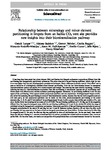Relationship between mineralogy and minor element partitioning in limpets from an Ischia CO 2 vent site provides new insights into their biomineralization pathway
| dc.contributor.author | Langer, G | |
| dc.contributor.author | Sadekov, A | |
| dc.contributor.author | Nehrke, G | |
| dc.contributor.author | Baggini, C | |
| dc.contributor.author | Rodolfo-Metalpa, R | |
| dc.contributor.author | Hall-Spencer, Jason | |
| dc.contributor.author | Cuoco, E | |
| dc.contributor.author | Bijma, J | |
| dc.contributor.author | Elderfield, H | |
| dc.date.accessioned | 2018-09-10T11:12:53Z | |
| dc.date.available | 2018-09-10T11:12:53Z | |
| dc.date.issued | 2018-09-01 | |
| dc.identifier.issn | 0016-7037 | |
| dc.identifier.issn | 1872-9533 | |
| dc.identifier.uri | http://hdl.handle.net/10026.1/12309 | |
| dc.description.abstract |
It has long since been noted that minor element (Me) partitioning into biogenic carbonates is sometimes different from Me partitioning into inorganically precipitated carbonates. The prime example is the partitioning coefficient, which might be lower or even higher than the one of inorganically precipitated carbonate. Such a difference is usually termed “vital effect” and is seen as indicative of a biologically modified minor element partitioning. Over the last three decades interest in conceptual biomineralization models compatible with minor element and isotope fractionation has been steadily increasing. However, inferring features of a biomineralization mechanism from Me partitioning is complicated, because not all partitioning coefficients show vital effects in every calcium carbonate producing organism. Moreover, the partitioning coefficient is not the only aspect of Me partitioning. Other aspects include polymorph specificity and rate dependence. Patellogastropod limpets are ideally suited for analysing Me partitioning in terms of biomineralization models, because they feature both aragonitic and calcitic shell parts, so that polymorph specificity can be tested. In this study, polymorph-specific partitioning of the minor elements Mg, Li, B, Sr, and U into shells of the patellogastropod limpet Patella caerulea from within and outside a CO2 vent site at Ischia (Italy) was investigated by means of LA-ICP-MS. The partitioning coefficients of U, B, Mg, and Sr (in aragonite) differed from the respective inorganic ones, while the partitioning coefficients of Li and Sr (in calcite) fell within the range of published values for inorganically precipitated carbonates. Polymorph specificity of Me partitioning was explicable in terms of inorganic precipitation in the case of Sr and Mg, but not Li and B. Seawater carbon chemistry did not have the effect on B partitioning that was expected on the basis of data on inorganic precipitates and foraminifera. Carbon chemistry did affect Mg (in aragonite) and Li, but only the effect on Mg was explicable in terms of calcification rate. On the one hand, these results show that Me partitioning in P. caerulea is incompatible with a direct precipitation of shell calcium carbonate from the extrapallial fluid. On the other hand, our results are compatible with precipitation from a microenvironment formed by the mantle. Such a microenvironment was proposed based on data other than Me partitioning. This is the first study which systematically employs a multi-element, multi-aspect approach to test the compatibility of Me partitioning with different conceptual biomineralization models. | |
| dc.format.extent | 218-229 | |
| dc.language | en | |
| dc.language.iso | en | |
| dc.publisher | Elsevier | |
| dc.subject | Mollusc biomineralisation | |
| dc.subject | Minor element fractionation | |
| dc.subject | Shell mineralogy | |
| dc.title | Relationship between mineralogy and minor element partitioning in limpets from an Ischia CO 2 vent site provides new insights into their biomineralization pathway | |
| dc.type | journal-article | |
| dc.type | Journal Article | |
| plymouth.author-url | https://www.webofscience.com/api/gateway?GWVersion=2&SrcApp=PARTNER_APP&SrcAuth=LinksAMR&KeyUT=WOS:000441892600012&DestLinkType=FullRecord&DestApp=ALL_WOS&UsrCustomerID=11bb513d99f797142bcfeffcc58ea008 | |
| plymouth.volume | 236 | |
| plymouth.publication-status | Published | |
| plymouth.journal | Geochimica et Cosmochimica Acta | |
| dc.identifier.doi | 10.1016/j.gca.2018.02.044 | |
| plymouth.organisational-group | /Plymouth | |
| plymouth.organisational-group | /Plymouth/Faculty of Science and Engineering | |
| plymouth.organisational-group | /Plymouth/Faculty of Science and Engineering/School of Biological and Marine Sciences | |
| plymouth.organisational-group | /Plymouth/PRIMaRE Publications | |
| plymouth.organisational-group | /Plymouth/REF 2021 Researchers by UoA | |
| plymouth.organisational-group | /Plymouth/REF 2021 Researchers by UoA/UoA07 Earth Systems and Environmental Sciences | |
| plymouth.organisational-group | /Plymouth/Research Groups | |
| plymouth.organisational-group | /Plymouth/Research Groups/Marine Institute | |
| plymouth.organisational-group | /Plymouth/Users by role | |
| plymouth.organisational-group | /Plymouth/Users by role/Academics | |
| dcterms.dateAccepted | 2018-02-28 | |
| dc.rights.embargodate | 2019-3-7 | |
| dc.identifier.eissn | 1872-9533 | |
| dc.rights.embargoperiod | Not known | |
| rioxxterms.versionofrecord | 10.1016/j.gca.2018.02.044 | |
| rioxxterms.licenseref.uri | http://www.rioxx.net/licenses/all-rights-reserved | |
| rioxxterms.licenseref.startdate | 2018-09-01 | |
| rioxxterms.type | Journal Article/Review |


